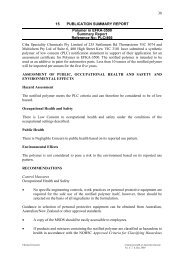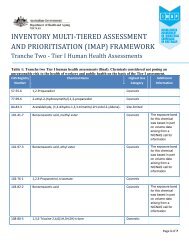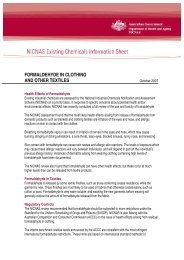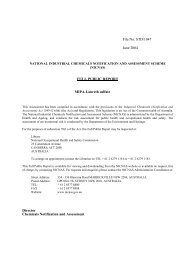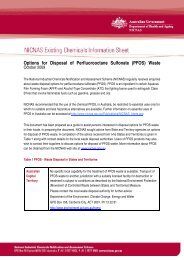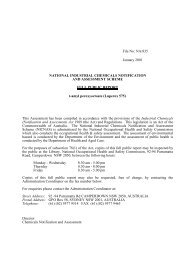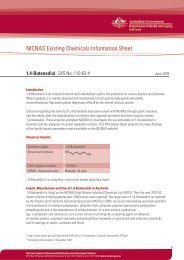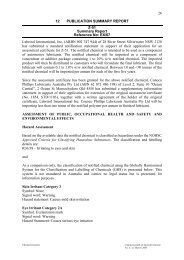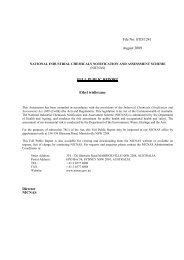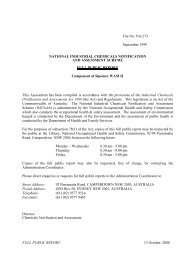GULFTENE C16-18 ISOMERISED OLEFINS - NICNAS
GULFTENE C16-18 ISOMERISED OLEFINS - NICNAS
GULFTENE C16-18 ISOMERISED OLEFINS - NICNAS
You also want an ePaper? Increase the reach of your titles
YUMPU automatically turns print PDFs into web optimized ePapers that Google loves.
R65 – May Cause Lung Damage if Swallowed;<br />
R66 – Repeated Exposure May Cause Skin Dryness or Cracking;<br />
S24/25 – Avoid Contact with Skin and Eyes;<br />
S28 – After contact with skin, wash immediately with plenty of soap and water; and<br />
S62 – If swallowed, do not induce vomiting: seek medical advice immediately and show this<br />
MSDS/label.<br />
Occupational Health and Safety<br />
Occupational exposure may occur during preparation of drilling mud, manipulation of<br />
contaminated drill bits and associated equipment and recycling of import containers.<br />
Gulftene 16-<strong>18</strong> is viscous and has low vapour pressure. Consequently, inhalation is not<br />
considered a significant route of exposure under normal use conditions. Eye and skin contact<br />
is expected to be the main route of exposure. Gulftene 16-<strong>18</strong> has low molecular weight, low<br />
water solubility and is lipophilic. The possibility of skin absorption through normal intact<br />
skin cannot be excluded. Furthermore, skin irritation and skin dryness may compromise the<br />
skin’s barrier function and subsequent exposure of damaged skin may promote skin<br />
penetration of the notified chemical.<br />
During drilling mud preparation and use and container recycling, Gulftene 16-<strong>18</strong> will be<br />
handled in a manner that is automated/mechanised, intermittent and non-dispersive, with<br />
workers required to wear personal protective equipment, namely impervious protective<br />
clothing, safety glasses with eye shields and nitrile, Viton, polyurethane, or chlorinated<br />
polyethylene gloves. In view of the frequency of contact, pattern of use and control measures,<br />
eye and skin contact is expected to be minimal and the risk of adverse health effects arising<br />
from the use of Gulftene 16-<strong>18</strong> is expected to be low. Aspiration into the lung after oral<br />
ingestion is a potential hazard; however, ingestion is not an expected route of occupational<br />
exposure.<br />
During import and transport of Gulftene 16-<strong>18</strong> or prepared drilling mud, there is unlikely to<br />
be any worker exposure, except in the event of a spill. Exposure after a spill would be<br />
controlled by use of the recommended practices for spillage clean up given in the MSDS<br />
supplied by the notifier.<br />
Public Health<br />
Public contact will only occur following accidental exposure from a spill or with contact with<br />
water containing the notified chemical following cleaning of empty drums. Consequently, the<br />
potential for public exposure to the notified chemical during all phases of its life cycle is<br />
considered to be low. Based on the above, it is considered that Gulftene 16-<strong>18</strong> will not pose a<br />
significant hazard to public health when used in the proposed manner.<br />
FULL PUBLIC REPORT 26 April 2000<br />
NA/713 Page 91 of 100



